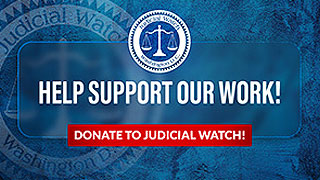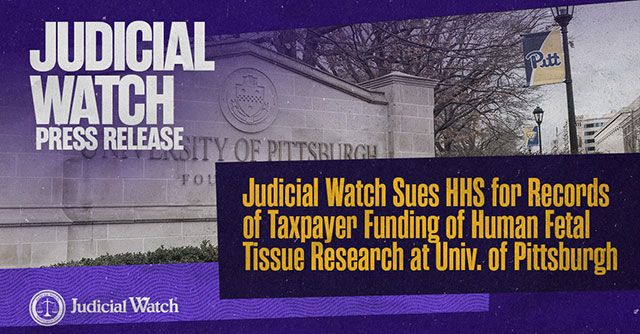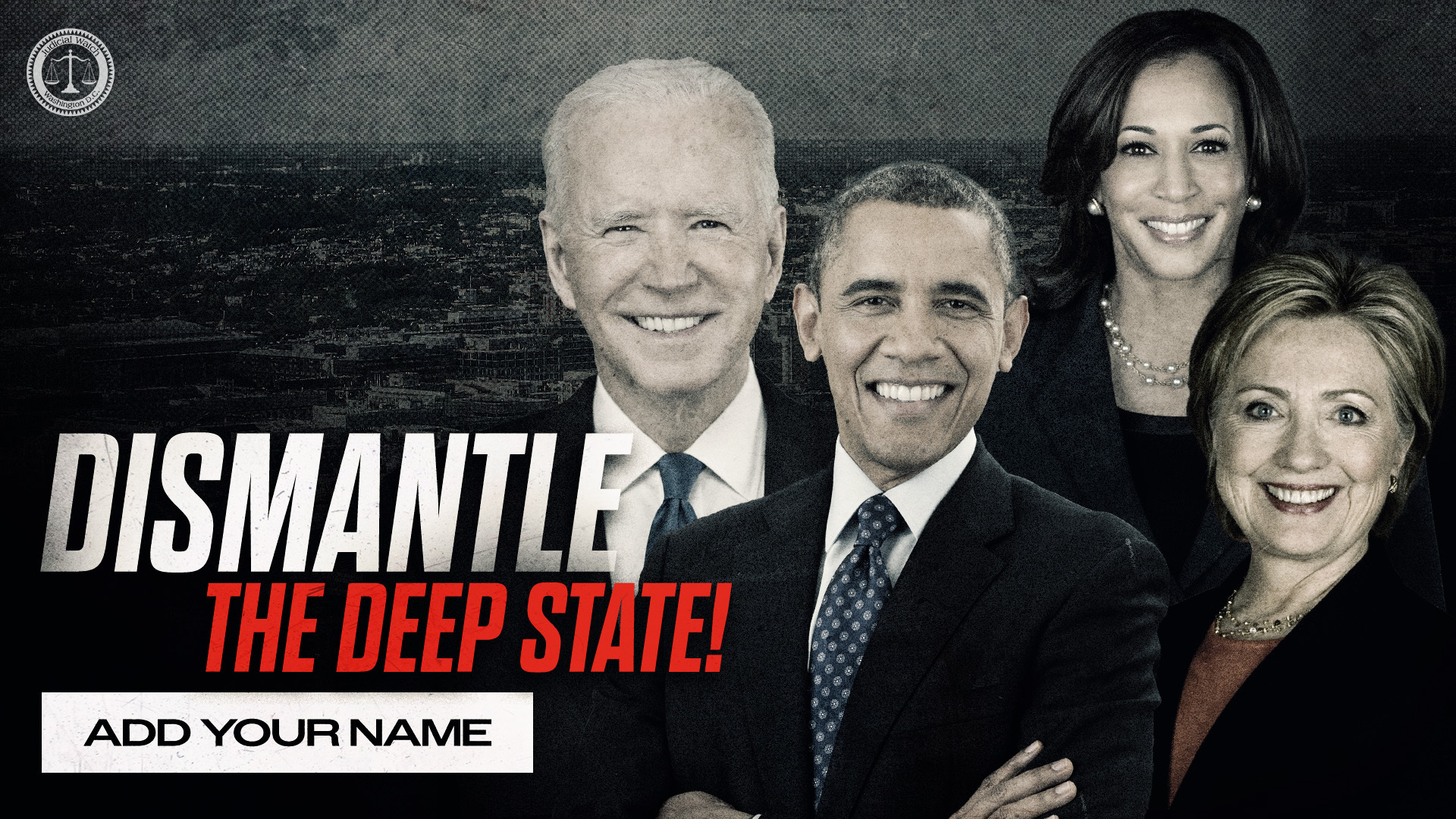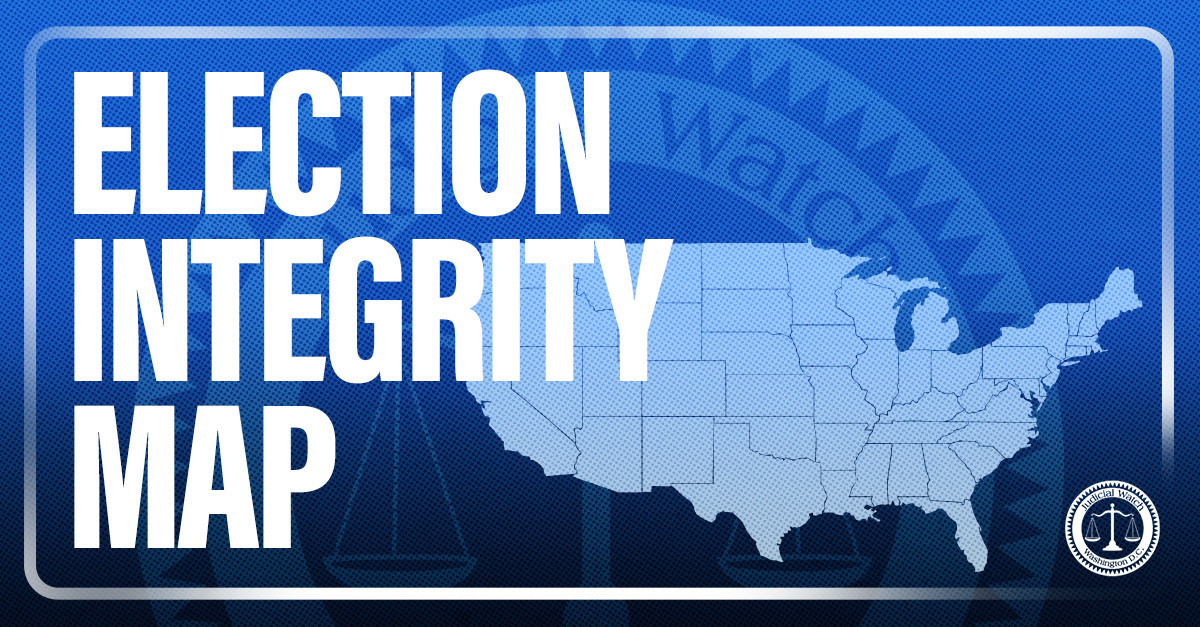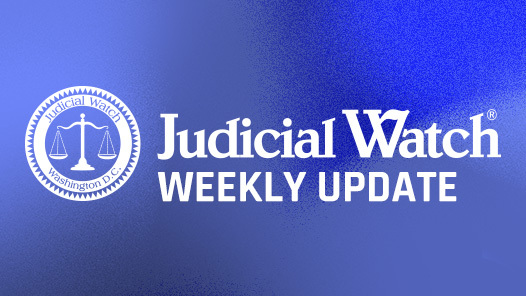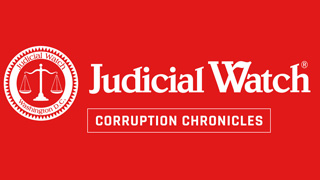
Judicial Watch: Documents Show Texas Researcher Warned Wuhan Lab of COVID Investigation by Congress
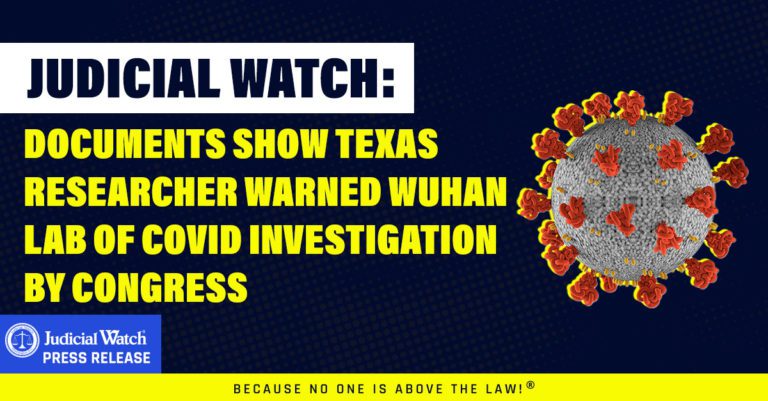
(Washington, DC) – Judicial Watch announced today that it obtained 412 pages of new records that show the former director of the Galveston National Laboratory at the University of Texas Medical Branch (UTMB), Dr. James W. Le Duc warned Chinese researchers at the Wuhan Institute of Virology of potential investigations into the COVID issue by Congress.
Additionally, the documents show Le Duc praising the Wuhan researchers and Chinese officials for their transparency and handling of the COVID-19 outbreak, and, in April 2021, Le Duc accepting a request to be on the Biosafety Advisory Committee of Westlake University in Hangzhou, China. (James Le Duc, PhD, is the former director of the Galveston National Laboratory, one of the largest active biocontainment facilities on a U.S. academic campus.)
The records were obtained in response to Judicial Watch’s January 20, 2020, Texas Public Information Act (PIA) request to the University of Texas Medical Branch (UTMB) that asked for:
All emails, email chains, text messages, email attachments, calendar invitations, and calendar invitation attachments by James W. LeDuc, former Director, Galveston National Laboratory, University of Texas Medical Branch, to and from domains ending in nih.gov or .cn (the Peoples Republic of China Government Domain) containing any of the following terms and parameters:
- Wuhan within 10 words of coronavirus OR covid* OR SARS-CoV-2;
- Wuhan within 10 words of mcl OR lab* OR institute;
- Wuhan within 10 words of virology OR virus OR disease*;
- Wuhan within 10 words of biocontainment;
- Wuhan within 10 words of safety OR scien* OR breach;
- Peter within 10 words of Daszak.
The records include an email dated April 16, 2020, with the subject line “Rubio” from former Commander of the U.S. Army Medical Research Institute of Infectious Diseases David Franz who informs Le Duc, “I heard from someone in government this evening that Senator Rubio is starting to push for an investigation regarding Wuhan lab. Just found it on the web at Forbes by Kenneth Repoza. Title of article is ‘eight senators call for investigation into coronavirus origins.’” (https://www.forbes.com/sites/kenrapoza/2020/04/16/eight-senators-call-for-investigation-into-coronavirus-origins/?sh=1ac354835049)
Le Duc then forwards the email to Dr. Shi Zhengli, a top Chinese virologist known for her work with coronavirus at the Wuhan Institute of Virology, requesting a phone conversation “soon” about the email.
On April 18, 2020, Zhengli rejects Dr. De Luc’s request: “Due to the complicated situation, I don’t think it’s a right time to communicate by the call. What I can tell you is that this virus is not a leaky [sic] from our lab or any other labs. It’s a shame to make this scientific question so complicated.”
Le Duc responds:
I understand completely and I certainly do not wish to compromise you personally or your research activities. Given our long history of collaborations between the GNL 9Galveston National Laboratory0 and the WIV (Wuhan Institute of Virology0, I have been approached repeatedly for details on our work. Attached is a draft summary that I will be providing to the leadership of our University of Texas system and likely to Congressional committees that are being formed now
The draft attachment was not included in the PIA production.
In an email dated April 20, 2020, Le Duc informs Zhengli and the Director of the Wuhan National Biosafety Laboratory at the Chinese Academy of Sciences Dr. Yuan Zhiming that he is concerned that the Wuhan lab would continue to be the focus of investigaton:
I’m afraid that this discussion will continue for some time regarding where early coronavirus work was being done, the role, if any, of the Wuhan CDC in research on bat-associated coronaviruses, and exactly when scientists at WIV [Wuhan Institute of Virology] first became aware of the new coronavirus and had possession of specimens in the WIV and where was that work done (level of biocontainment).
A February 9, 2020, email from Le Duc prepares Zhiming with questions that may arise in an investigation of the origins of the COVID-19 virus. Le Duc warns that questions about the virus originating from the Wuhan Institute of Virology initially came only from social media, but had recently expanded to “alternate information sources,” “senior officials” and “reputable newspapers” all linking the opening of the ABSL 4 facility at the as the source of the virus outbreak.
I just think that we need to aggressively address these rumors and presumably false accusations quickly and provide definitive, honest information to counter misinformation. If there are weaknesses in your program, now is the time to admit them and get them corrected.
I trust that you will take my suggestions in the spirit of one friend trying to help another during a very difficult time.
Questions Le Duc attached for Zhiming to help prepare include:
Where is coronavirus research conducted?
-
- What level of biocontainment?
- How many different laboratories actually handle live virus?
- Where are coronavirus stocks stored?
- Is there an inventory record of each isolate of each coronavirus kept? If so, are there any discrepancies between the record and actual current inventory number (i.e., is there evidence to suggest that virus stocks may have been stolen or used without proper record?)
Virus Stocks
-
- What are the coronaviruses in your possession that are most closely related to nCoV [novel coronaviruses] based on genetic sequences and are able to replicate in culture?
- Is anyone on your team conducting gain of function studies, recombination studies or any other studies that may have resulted in the creation of the nCoV?
Personnel
-
- How many people have access to the coronavirus stocks and laboratory?
- Senior investigators? Junior investigators? Technical support staff? Post-docs? Students? Animal handlers? Janitors and other cleaning staff? Building support personnel? Others?
- Does the Institute have an occupational health clinic where employees and students can go to seek medical care? If so, was there any indication of unusual illness similar to that seen for nCoV among Institute staff?
- Does a serum bank exist for staff and students working on infectious agents? If yes, could a current serum and the most recent banked sera be serologically tested for antibody to nCoV in an effort to document seroconversion?
Geography
-
- Where and when were the first Wuhan (or Hubei Province) residents infected with the nCoV first identified (hospital or clinic name/date of earliest cases)?
- Do staff members of the Institute reside in the district serviced by this (these) hospital/clinic(s)?
- Do staff members of the Wuhan Institute of Virology frequent the sea food/live market first associated with the nCoV outbreak?
- Did any staff member visit the market in the weeks prior to it being closed? If so, how many staff frequent the market? How often would they visit the market during the period of interest?
In an April 26, 2021, email Ting Yuan from the Center for Infectious Disease Research at Westlake University in China writes to Le Duc regarding an official appointment as “a member of Biosafety Advisory Committee” and asks for his input “while we are building our BSL-3 labs.” Later that day, Le Duc accepts the offer.
In an email dated May 6, 2019, Le Duc thanks the National Institutes of Allergy and Infectious Diseases (NIAID) regional program officer for Global Research for East/South Asia and Pacific Gale Bernabe for taking his call to discuss “possible funding sources for collaborative work with China.”
Le Duc informs Bernabe about a proposal to begin work in Wuhan later in the year.
We have already submitted a proposal and if successful we would begin work in Wuhan later this year. My goal is to Identify a similar funding mechanism that would allow the US side partners to receive similar support for these collaborations. Our vision is that the work will be conducted in true collaboration with some undertaken in the US and some in Wuhan by investigators that are in frequent contact and visiting each other frequently
Le Duc attaches two documents titled: “Wuhan National Biosafety Laboratory, Chinese Academy of Sciences Advanced Customer Cultivation Project Call Announcement” and “Wuhan National Biosafety Laboratory, Chinese Academy of Sciences Advanced Customer Cultivation Project Application Form.”
On November 25, 2019, Le Duc emails Zhiming, commenting on a draft manuscript titled, “China’s First Biosafety Level 4 (BSL-4) Laboratory for Fighting Infectious Disease.”
Le Duc informs Zhiming that his paper was “nicely written” concerning biocontainment labs in China, however, the paper should be expanded “to let readers know that security is an important aspect of your program.”
In an email dated January 16, 2020, Le Duc congratulates Dr. George F. Gao, director-general of the Chinese Center for Disease Control and Prevention (China CDC), on his leadership and China’s response to COVID-19. Le Duc includes two articles of interest and further states:
As you might expect, we are following the evolving story on nCoV from Wuhan very closely and we are eager to get an isolate for antiviral testing. Dr Tseng’s [https://microbiology.utmb.edu/faculty/chien-te-(kent)-tseng-phd] lab here in the GNL [Galveston National Laboratory] has developed a transgenic mouse model for SARS that is very useful and we are anxious to see if it can be used for the nCoV [novel coronavirus] as well.
In an email dated January 21, 2020, Le Duc attached a draft of his Houston Chronicle op-ed, advising the following people that it had been “slightly modified:”
-
- Benjamin Rusek, National Academy of Sciences
- Dave Franz, Commander of the U.S. Army Medical Research Institute of Infectious Diseases (Retired)
- Dr. Yuan Zhiming
- Dr. George F. Gao
- Mifang F Liang, Chinese Center for Disease Control and Prevention
- Dr. Pei-Yong Shi, Associate Chief Research Officer, Galveston National Laboratory, UTMB
In an email dated March 20, 2020, Le Duc thanks Zhiming for his, “heroic efforts to control the epidemic in Wuhan. Your success is an inspiration to all of us as we work to halt transmission here in the USA and in other countries.”
Le Duc informs Zhiming that the U.S. was at the start of the “explosion of cases in our region and over the next few weeks we would see very high numbers of cases requiring hospitalizations and ICU support,” and suggests that “it would be excellent if we could identify areas for collaborations.”
In an April 29, 2020, email, NIAID Associate Director for International Research Affairs Gray Handley informs Le Duc of an inquiry from U.S. Embassy in Beijing, “asking what was the official name of your DoD supported training program and some other background information.,,, Also, can you assure these responses to their questions are accurate?”
To the question: “Did this training take place in the U.S., China, or in both countries?” Handley writes that since 2013, the Galveston National Laboratory, UTMB, was “part of the NIH Biodefense Laboratory Network [and] provided laboratory safety and security training for high-level biocontainment facilities in China, including the Wuhan Institute of Virology.”
To the question: “Is this relationship still ongoing?” Handley writes: “This relationship has been facilitated since 2015 through an ongoing dialogue and regular collaboration meetings cosponsored by the Chinese Academies of Science and the U.S. National Academies of Science, Engineering and Medicine with cooperation from the Chinese CDC and others.”
Le Duc responds to Handley: “The title for both projects was National Biocontainment Training Center.
The Center was supported by two separate awards: W81XWH-09-2-0053 covering the period [May 22, 2009, to December 21, 2014], and W81XWH-11-2-0148 covering the period [July 2011 to July 2016].”
In an email dated February 20, 2021, Zhiming responds to a “Happy New Year” note from Le Duc:
During the last year, we all experienced the hardest time, fighting against the virus, fighting against the rumors. The lab operated smoothly [and] efficiently, providing a crucial platform for pathogen identification, animal modeling, antiviral drug screening and vaccine development, and we are very proud of the role and achievements of the laboratory. Here, I would like to express my sincere thanks to you and your colleagues for your assistance for the safety and secure operation of the lab.
I really hope you could come back here after the epidemic, and we could share our understanding on lab management and infectious disease control.
“These startling documents show that China had partners here in the United States willing to go to bat for them on the Wuhan lab controversy,” said Judicial Watch President Tom Fitton.
Through FOIA requests and lawsuits, Judicial Watch has uncovered a substantial amount of information surrounding COVID-19, to include the communications of Anthony Fauci and other U.S. officials, as well as biosafety issues here in the United States. The findings include:
- May 2022: HHS records regarding biodistribution studies and related data for the COVID-19 vaccines show a key component of the vaccines developed by Pfizer/BioNTech, lipid nanoparticles (LNPs), were found outside the injection site, mainly the liver, adrenal glands, spleen and ovaries of test animals, eight to 48 hours after injection.
- April 2022: Records from the Federal Select Agent Program (FSAP) reveal safety lapses and violations at U.S. biosafety laboratories that conduct research on dangerous agents and toxins.
- March 2022: HHS records include emails between National Institutes of Health (NIH) then-Director Francis Collins and Anthony Fauci, the director of National Institute of Allergy and Infectious Diseases (NIAID), about hydroxychloroquine and COVID-19.
- March 2022: HHS records show the State Department and NIAID knew immediately in January 2020 that China was withholding COVID data, which was hindering risk assessment and response by public health officials.
- December 2021: HHS records include a grant application for research involving the coronavirus that appears to describe “gain of function” research involving RNA extractions from bats, experiments on viruses, attempts to develop a chimeric virus and efforts to genetically manipulate the full-length bat SARSr-CoV WIV1 strain molecular clone.
- August 2021: HHS records include an “urgent for Dr. Fauci ” email chain, citing ties between the Wuhan lab and the taxpayer-funded EcoHealth Alliance. The government emails also report that the foundation of U.S. billionaire Bill Gates worked closely with the Chinese government to pave the way for Chinese-produced medications to be sold outside China and help “raise China’s voice of governance by placing representatives from China on important international counsels as high level commitment from China.”
- July 2021: NIAID records reveal that it gave nine China-related grants to EcoHealth Alliance to research coronavirus emergence in bats and was the NIH’s top issuer of grants to the Wuhan lab itself. The records also include an email from the vice director of the Wuhan Lab asking an NIH official for help finding disinfectants for decontamination of airtight suits and indoor surfaces.
- June 2021: HHS records reveal that from 2014 to 2019, $826,277 was given to the Wuhan Institute of Virology for bat coronavirus research by the NIAID.
- March 2021: HHS records show that NIH officials tailored confidentiality forms to China’s terms and that the World Health Organization (WHO) conducted an unreleased, “strictly confidential” COVID-19 epidemiological analysis in January 2020.
- October 2020: Fauci emails include his approval of a press release supportive of China’s response to the 2019 novel coronavirus.
###









